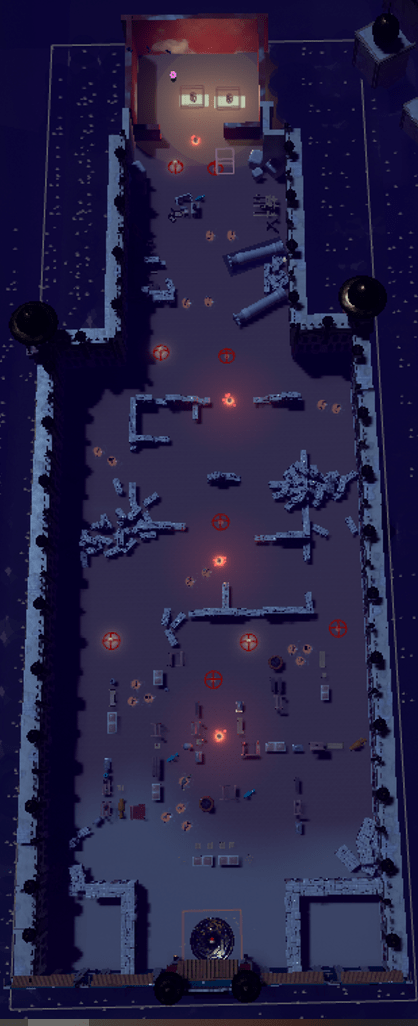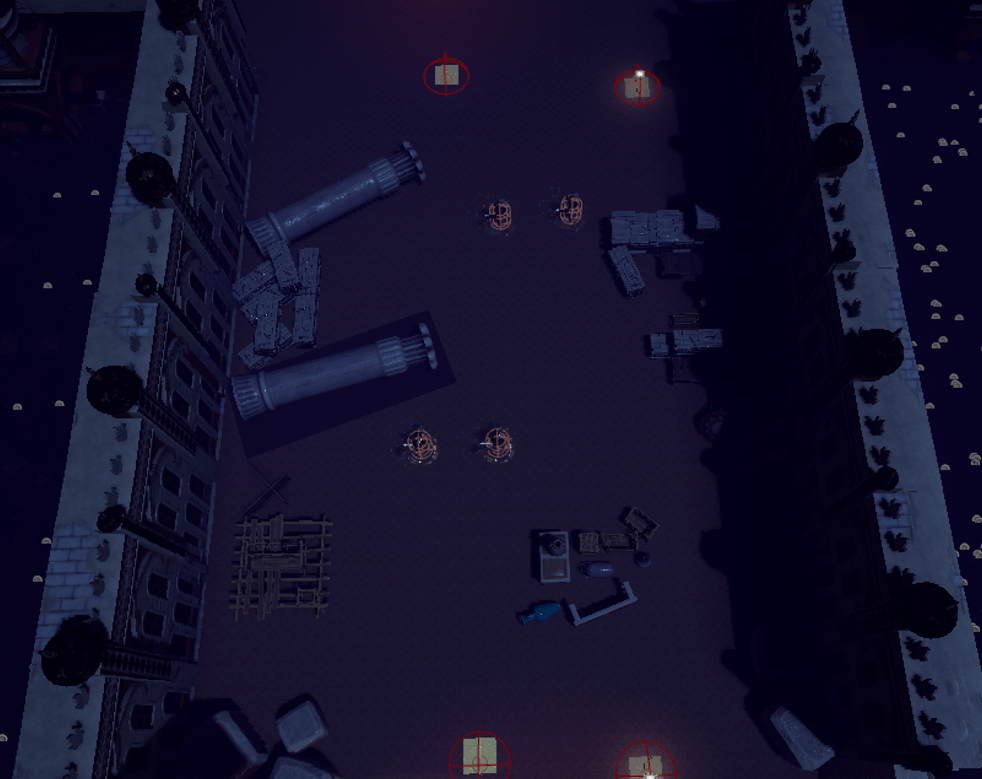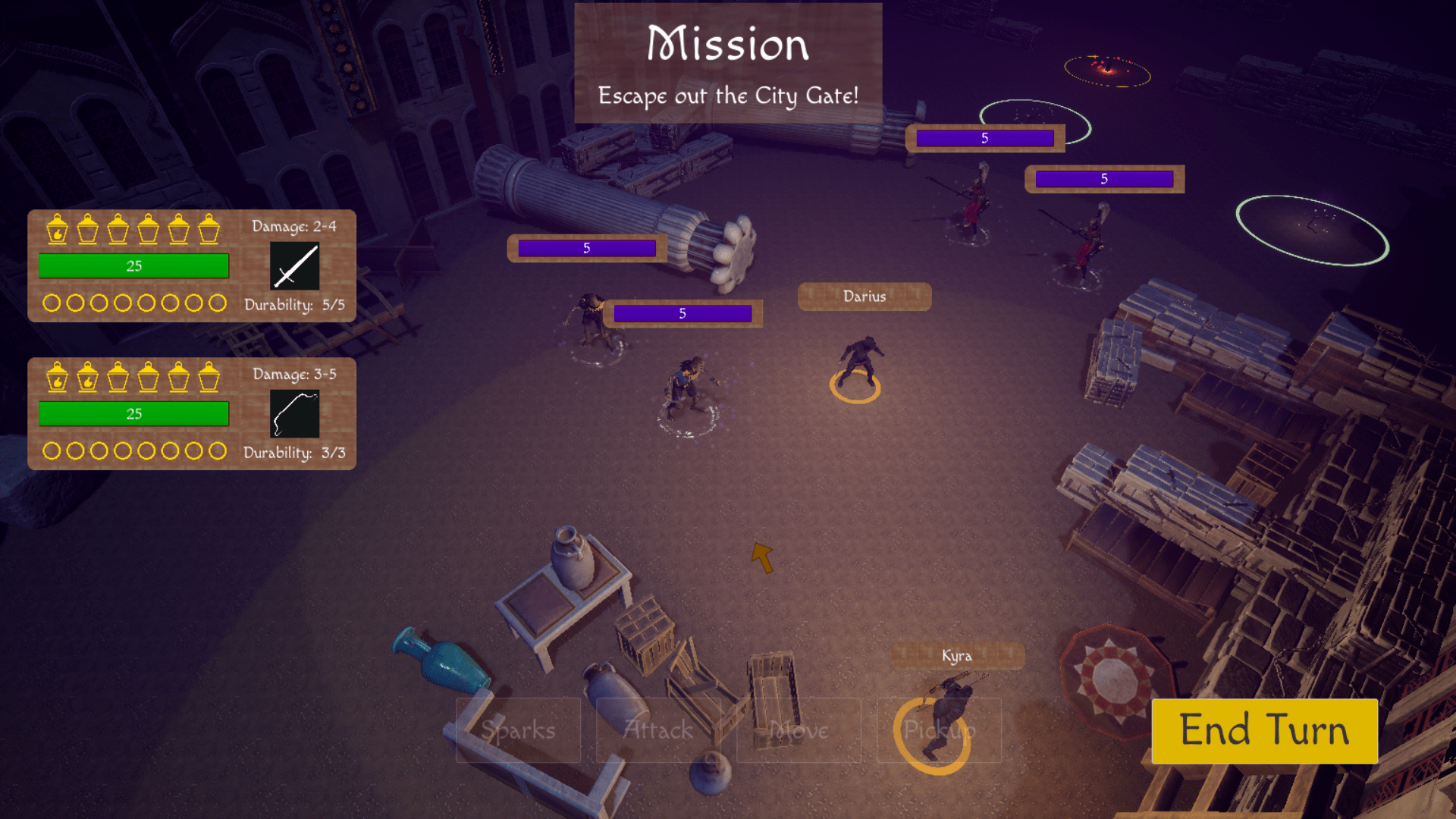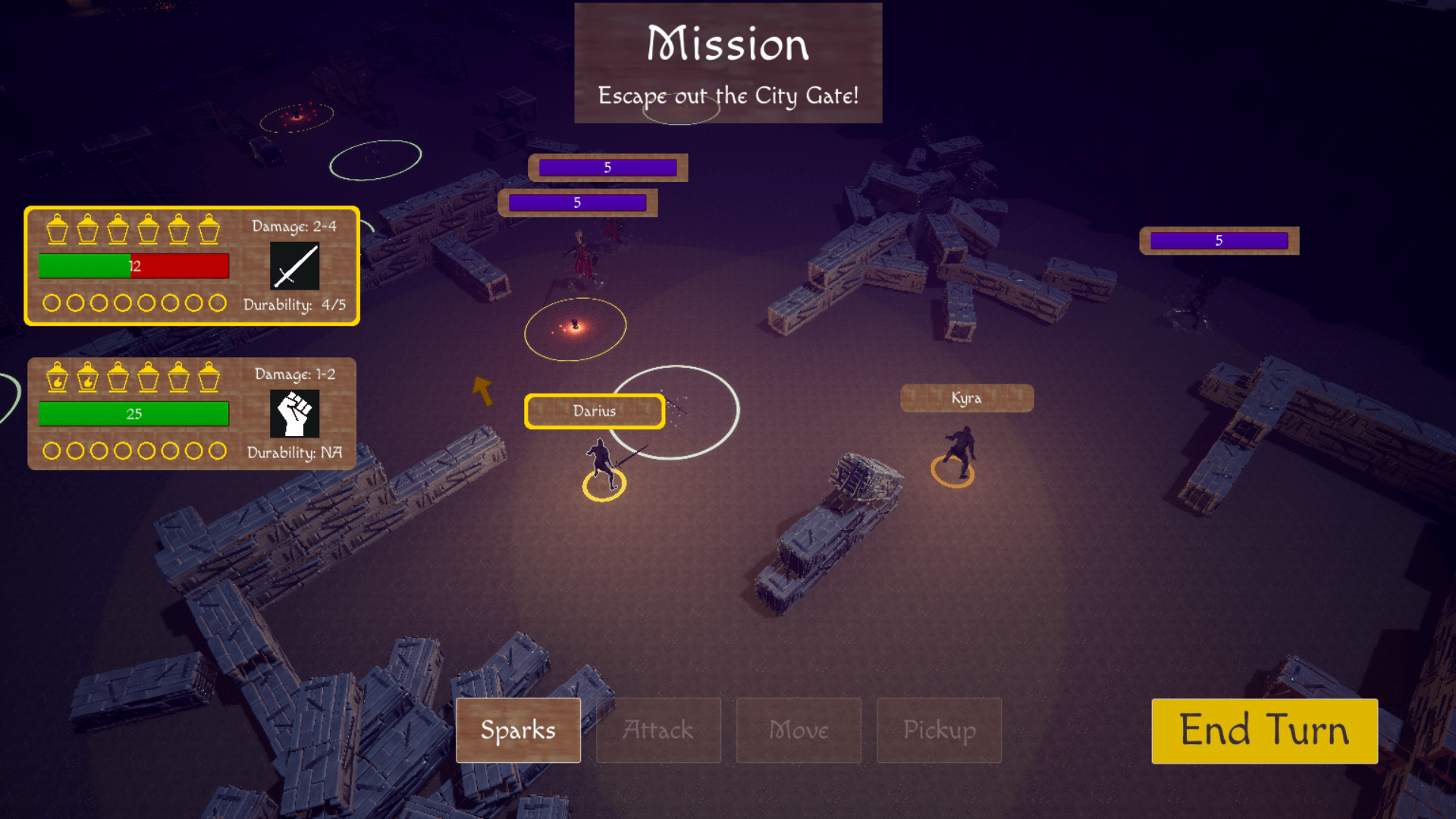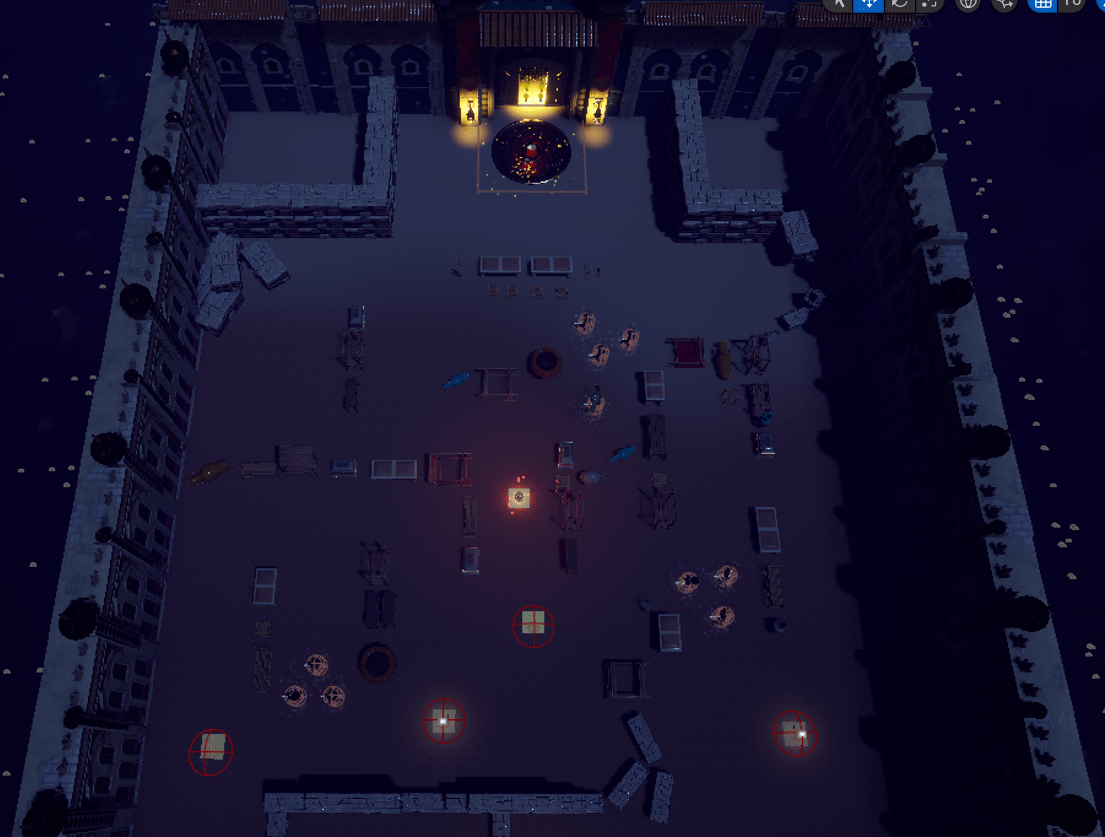
Inner Spark
Turn-Based Strategy
Inner Spark is a turn-based strategy game with a focus on resource management and survival. In it, players take control of two survivors of a city under siege by evil in their struggle to escape. They must put their skills to the test and call upon the power of light in order to make it out alive.
Project Spec.
Created over 8 months
12 person interdisciplinary team (Design, Sound, Tech)
Created in Unreal 5.1
Worked as Creative Director and Level Designer
Early Prototyping
Inner Spark takes lots of inspiration from games such as XCOM 2, so our original design for the game was grid based. This would theoretically make it easier to design levels as I would be able to snap things to the grid and ensure everything was the proper size for the game. The image to the left shows a very early iteration utilizing the grid to create a building with multiple floors and a surrounding play area. The idea for the level would be to create the entire playable area using the grid and use Unreal’s landscaping tools to create a visual layer on top of it as well as the rest of the surrounding city and dessert.
As development of the game went on however, it became apparent that the grid was more of a hinderance for the tech team than a benefit. Because of this, we ended up cutting the grid from the game. This made it so I had to rethink how I wanted to make the levels, but it did allow me to try to make a more dynamic environment for the level. Without the rigidity of the grid, I experimented with the terrain and having building on hills.
One of the biggest challenges during these early prototypes was making buildings with multiple floors without obstructing the bottom floor since we didn’t have camera occlusion working. To do this I tried to either make them a narrow passageway or have part of the bottom floor be destroyed and unplayable.
Layout
After the early prototyping and scrapping the grid, I started using more free-form structures to create definable spaces within the level. Originally we had a much larger level split into five encounters instead of three, but this proved to be too long for the project constraints. After deciding to cut down to three encounters, it became more manageable and easier to distinguish between each encounter from a gameplay and visual standpoint.
For the layout of the level, I decided to go with a very straightforward approach while still offering multiple routes through the second and third encounter spaces. Each encounter has a unique feel to it so the player can see and feel when they move from one part of the level to another. The first area represents a small street area outside the building the player starts in to introduce the player to the game and make it feel like they are leaving their home into the chaos of the siege. The second encounter takes place in a destroyed building to show the the real danger of the enemies sieging the city. The final encounter of the game takes place in a market square near the gates of the city, creating a mazelike feel as the player navigates through the different stalls and rush to the gates to escape.
The equipment resupplies at the beginning of each encounter help guide the player forwards, with sparks to refresh player special abilities leading down the golden path. While the equipment and sparks lead players down the main path, the player has the opportunity to approach encounters from different angles. The third encounter is split into two different branches that provide different equipment options that combine for the final part of the level. Having multiple options for moving through the level makes the space more engaging and adds some replayability, along with experimenting with different strategies using their abilities.
Encounter 1
The first encounter of the game is meant to help introduce the player to the mechanics and allow them to practice what they see in the tutorial slides. The player is able to acquire one of each weapon as well as a spark before engaging any enemies, which allows them to experience all player mechanics in the game from the start. Being able to use all of the game’s mechanics in the first encounter lets the player begin experimenting with strategies as soon as possible in order to find their preferred play style.
The first encounter only introduces the basic melee and ranged enemies of the game to stop the player from getting overwhelmed. Having only a couple types of enemies to deal with combined with Inner Spark being turned based helps the player get accustomed to game with little risk of defeat.
The small amount of enemies right outside helps introduce the narrative of Inner Spark by making it feel like the player is fighting the forward troops of the army laying siege to the city. It feels like the characters are fleeing from their home and fighting off a few enemies while trying to figure out what’s going on.
The first encounter is also the only encounter of the game that the player cannot choose their approach when entering. This is because we wanted the first encounter to be the same for everyone so that it effectively teaches the mechanics and setting. If the player could choose how to enter the first encounter, it could take away a lot of the tutorialization and make it far more difficult for first time players to get familiar with the game.
Encounter 2
The second encounter of the game begins to evolve the gameplay and make the player think about positioning and ability use more than the first encounter. This encounter is split into three groups that can surround the player if they are not careful about how they approach the situation. This portion of the level can also be entered through three different entrances, with the most straightforward containing a spark to guide the player.
Part of what this encounter does is introduce the bomber enemy, a devastating enemy that will detonate for massive damage if it is not dealt with. This new enemy forces the player to adapt and prioritize their targets. Since the objective is simply to escape, the player can also try to outrun the bomber, but this tactic has the risk of further danger later if the player is stopped by other enemies.
The increased number of enemies along with introducing a new enemy type help put a heavy emphasis on using the special spark abilities the player has access to in order to increase their chances of survival. Spark abilities can be combined to create powerful combos, but they require set up and planning to pull off.
The crumbling building the player moves through in this segment of the game and the presence of the bomber enemy show the player just how serious and dangerous the siege of the city is. The city being destroyed around them encourages the player to keep moving forward and try to escape as quickly as possible.
Encounter 3
The final encounter of the game has the player nearing the gates of the city and the escape they offer, but first they must navigate through a marketplace in ruins. This encounter takes place directly after the second encounter with very little downtime, making it feel more intense. The final encounter is split into multiple pods, with the player able to maneuver through the space in such a way that they can avoid at least one.
The market houses the final enemy type of the game, a singular tank enemy that has more health and deals more damage than the other standard enemies. It proves a significant challenge to the player as they are typically low on supplies and health at this point in the game. The area the player fights the boss in is very tight, but designed in a way that they can try to run through to the exit. This allows the player the choice of just trying to complete the objective of the game and escape instead of trying to fight and kill everything.
The final encounter of the game is by far the most challenging due to player resources being drained and more difficult enemies being present, forcing the player to utilize everything they have and approach situations carefully. This is meant to emphasize that the player cannot take on the whole army and must abandon their home and save themselves.
This encounter is also split into two main paths the player can approach from before joining back together to create a narrow passageway before splitting back out into multiple paths the player can take. Each route provides the same equipment, but it is placed in a different order to make fighting the identical enemy pods feel different while remaining balanced. Moving through the different branches also feels different as one is much more compact and linear while the other allows for more freedom of movement.
Project Takeaways
One of the most valuable lessons I learned from working on this project was how to work on a larger, multi-discipline team. With more people working on the project, it created more restraints for what I could be working on and when. This issue helped strengthen my communication skills and time management as I had to work with anyone else who might need to do something in the level file and coordinate when we could each do things and for how long. Working as the creative director for the team also influenced my growth in this area because I had to keep track of what each of my design team was doing and work with the tech and audio departments on the team to make sure everything we needed was getting done.
Another lesson I learned while working on this project was how to effectively do rapid iterations on my level. During the development of Inner Spark, there were some technical issues that arose and mechanics that needed to be cut. This caused me to have to redo aspects of the level to reflect the changes in what the player can do in the game. Having to heavily modify or make a completely new version of the level every week helped me improve my ability to create these levels more efficiently. This process also taught me that it’s ok to redo things if needed and how not to get too attached to any specific aspects of a level I’m working on.


